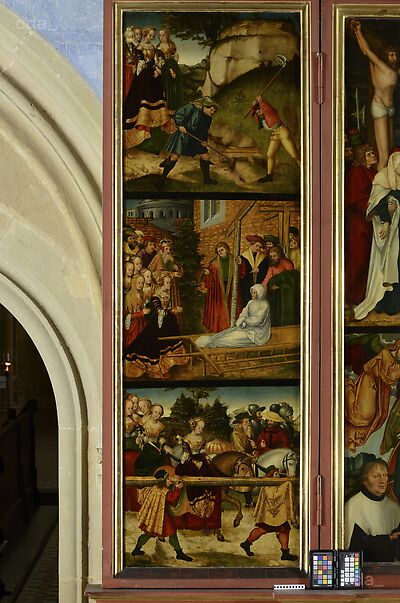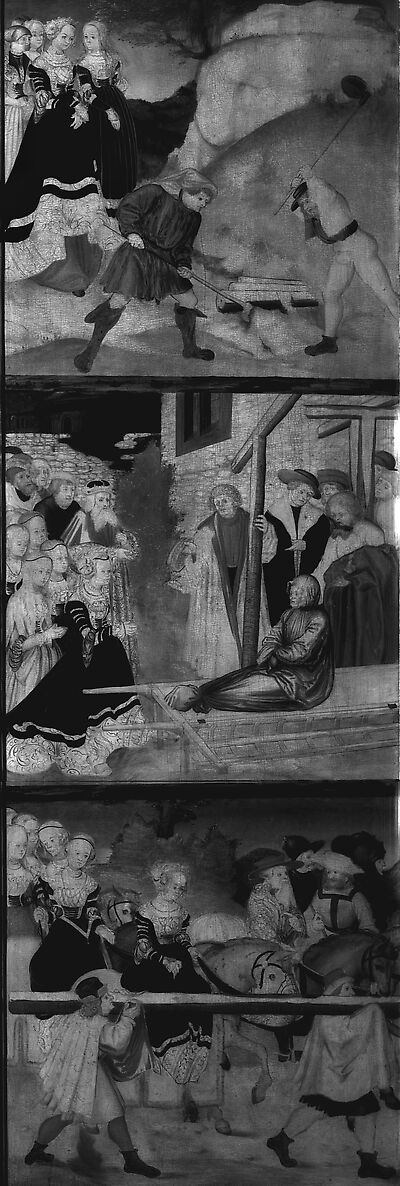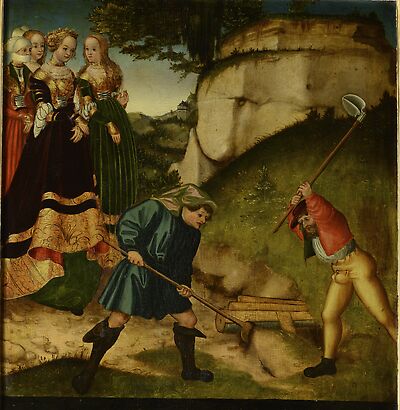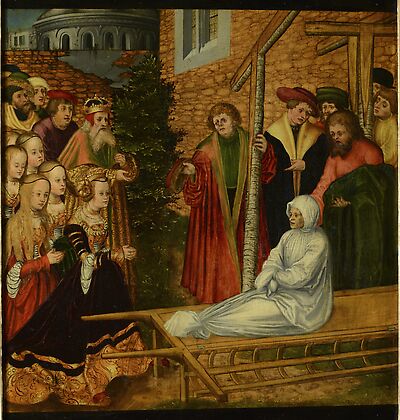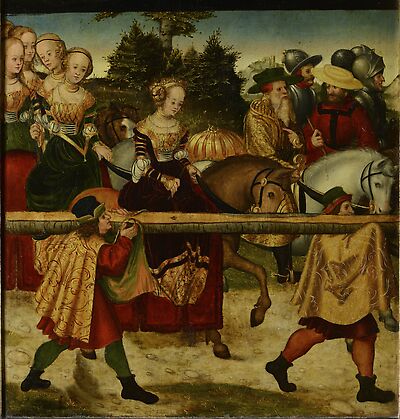Recto, top field: the empress Helena discovers the true cross
The empress, surrounded by three women from her court, orders a search for the true cross, which along with two other crosses is unearthed from the ground by two men with picks and spades.
[Gurlitt 1920, 220]
Recto, central field:
Recto, top field: the empress Helena discovers the true cross
The empress, surrounded by three women from her court, orders a search for the true cross, which along with two other crosses is unearthed from the ground by two men with picks and spades.
[Gurlitt 1920, 220]
Recto, central field: the miracle healing performed with the true cross
The cross proves its miraculous power. The empress and her four companions kneel in front of a hand-bier from which a female figure covered by a silk cloth rises. The emperor is visible on the left in the background with a crown on his head. Behind the bier there is a man with a miraculous circle. Two other men hold the thieves crosses.
[Gurlitt 1920, 220]
Recto, lower field: Transportation of the cross
The emperor and the empress are on horseback, accompanied by noble women and knights. Two men carry the cross away on their shoulders.
[Gurlitt 1920, 220]
Verso:
Christ as the Man of Sorrows is depicted as a full-length figure against a black background and stands on a stony ground. Christ is turned to the right. His arms are crossed in front of his chest and he hold the whip and rod in his hands. On his head he wears a crown of thorns. His body is covered with a large number of wounds and blood. His white loin cloth remained without a stain.
[Görres, cda 2013]
![Altarpiece of the Laity [left wing]: discovery, miraculous healing and transport of the Holy Cross [recto], Man of Sorrows [verso]](https://lucascranach.org/imageserver-2022/DE_DM_NONE-DM004B_FR-none/01_Overall/DE_DM_NONE-DM004B_FR-none_2013-02_Overall-s.jpg)
![Altarpiece of the Laity [central panel]: Crucifixion, The Sacrifice of Isaac,The Brazen Serpent](https://lucascranach.org/imageserver-2022/DE_DM_NONE-DM004C_FR-none/01_Overall/DE_DM_NONE-DM004C_FR-none_2013-02_Overall-s.jpg)
![Altarpiece of the Laity [right wing]: Vision of Constantine, entry in imperial robe, entry in penitential robe [recto], Mother of Sorrows [verso]](https://lucascranach.org/imageserver-2022/DE_DM_NONE-DM004D_FR-none/01_Overall/DE_DM_NONE-DM004D_FR-none_2013-02_Overall-s.jpg)
![Altarpiece of the Laity [right fixed wing]: lion and bull as symbols of the evangelists](https://lucascranach.org/imageserver-2022/DE_DM_NONE-DM004E_FR-none/01_Overall/DE_DM_NONE-DM004E_FR-none_2013-02_Overall-s.jpg)
![Altarpiece of the Laity [predella]: Holy Mass and Purgatory](https://lucascranach.org/imageserver-2022/DE_DM_NONE-DM004F_FR-none/01_Overall/DE_DM_NONE-DM004F_FR-none_2013-02_Overall-s.jpg)
![Altarpiece of the Laity [left fixed wing]: eagle and angel as symbols of the evangelists](https://lucascranach.org/imageserver-2022/DE_DM_NONE-DM004A_FR-none/01_Overall/DE_DM_NONE-DM004A_FR-none_2013-02_Overall-s.jpg)
